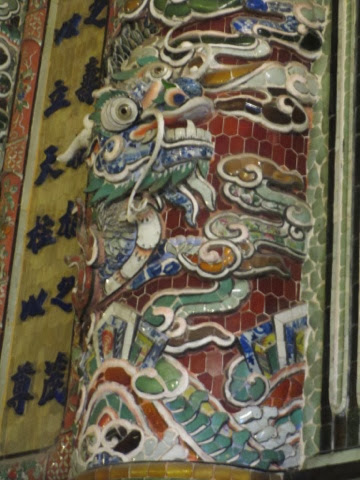The first day we arrived Cat and I were both still hungover from the $5 all you can drink - so we took it easy, the main focus for the day was to explore some of the food options and get orientated in the city. Luckily it wasn't raining so we managed to walk around everywhere without being soaked (more on this to come).
We stopped at a vegetarian restaurant recommended by both Lonely Planet and our hostel - what we ate I couldn't tell you apart from spring rolls (Nam Ran), but it came recommended by the waitress and was tasty and interestingly different.
Spring rolls at the back - random plate of 8 mixed destinies at the front (really that's what the menu said!) - I liked pink triangles, Cat the green...
After being sated by vegetables we wandered around the markets in town - checking out the fruit section and ignoring the ladies wanting to sell us stuff or cut our hair (I'd rather do that at a salon not in the market!)
Walking down the river everyone wanted us to get their dragon boat to the Citadel - given that we were going to be doing this the following day we declined.
Most of the riverside is taken up by advertising - we certainly couldn't see any of the old imperial city anywhere we looked.
We managed to find something without neon! Dieu De pagoda is outside the walled old town, and was a National Pagoda under the direct patronage of the emperor Thieu Tri (1841-47). It's famous for its four low towers and was a stronghold of Buddhist & student opposition to the war in Vietnam.
Next we went on a hunt to find the old town, surrounded by a moat and city walls we didn't realise it would be so difficult! Eventually we found the walls and a gate in.
We climbed right to the top of the gate house past a family with a delightful little girl who loved to wave at us.
So the following day with our tomb and Citadel tour rainy season started with a vengeance. Suited up in plastic ponchos and with dodgy cheap umbrellas at the ready we soldiered on to see the tomb of the second emperor of the Nguyen Dynasty - Minh Mang who reigned from 1820 to 1841.
He built this tomb whilst he was still alive and used to visit it during the summer each full moon. The site took 8 years to find (Feng Shui to blame for that) and is located on the perfume river - so a quick boat from Hue city. What's interesting is that the layout of the site seen from above looks like a man sleeping with his arms crossed.
I can imagine how lovely this site would be in summer when the trees and plants are in full bloom and the lake is full of lotus flowers. While we were there it was just wet!! Not everyone gets to see the mini waterfalls cascading off the pagoda steps...
The next tomb we visited was Khai Dinh (12th and second to last emperor from 1916-25) on the slope of Chau Chu mountain - it took him 15 years to find the perfect site.... This tomb is very different from Minh Mang's as you'd expect with a century between them.
It sits dark and brooding on the mountain side - well it looked brooding in the rain! Apparently the stone and the local climate combined mean that the originally white stone turned black within a few months.
The outside of the tomb shows a wealth of decoration and not just in the chinese style. Khai Dinh incorporated elements from all major religions - stupas from Hinduism, crosses from Christianity, lotus flowers from Buddhism and similar statues as his ancestors.
However the inside of the tomb was the most surprising bit...
The mosaics decorating the inside are amazing - it took 5 years to design and included work from Japan. The mosaic pieces are made up of lots of different things - pieces of beer bottle, ceramic soup spoons etc but the overall impression is majestic. The dragon murals on the ceiling are also stunning.
After a quick stop to watch the imperial martial art, Kinh Van An, they can be lethal with a hand fan, we headed to the final tomb of the day - Tu Duc's. He was the fourth emperor from 1847- 1883 and unfortunately had no sons.
This meant that he had to write his own life story for the Steele outside his tomb. All the other emperor's sons did this for them after their death.
Entrance to Tu Duc's tomb
To continue the Nguyen dynasty he adopted two of his brother's sons, however the dynasty didn't necessarily pass the succession down through the eldest son - Minh Mang had 144 children from his wife and concubines and could choose the best to succeed him. I can imagine the politics and infighting amongst the women to get their children higher status.
Next stop was the Citadel - which housed the Forbidden City with the palaces for the Emperor, his first wife, the Queen mother, and the concubines & children. This was built by Minh Mang of 144 children so there was lots of space!
Flag in the rain on the way into the Citadel
Decoration inside one of the structures - we saw workmen lacquering the other side.
Our final stop on this epic city tour was the Thein Mu pagoda
Finally after a cold dragon boat back into the hotel district we sat down for Bun Bo Hue - the local version of noodle soup and Banh Khoai pancakes - traditional Hue delicacies and warming too!











































No comments:
Post a Comment